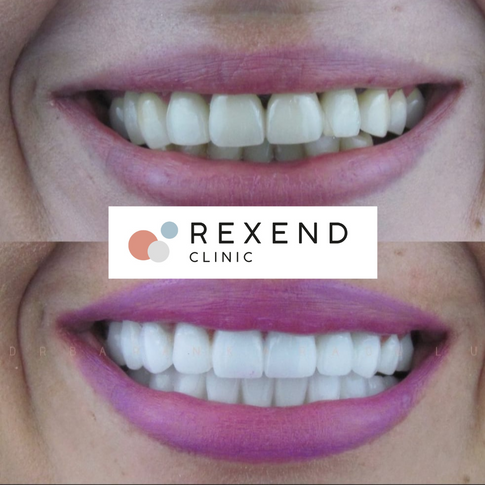What are you interested in ?

Tooth whitening
What is it ?
A real promise of seduction and health, having a pretty smile inevitably involves white and well-aligned teeth. However, different factors of a hereditary nature (natural coloring or aging of the tooth), pathological (tetracycline intake during the period of tooth formation) or even from lifestyle (consumption of coffee, tea, tobacco, etc.) sometimes make yellow or stained teeth.
What is the process ?
This simple cosmetic dentistry process is used to lighten the discoloration of enamel and dentin through the use of a gel based on hydrogen peroxide (hydrogen peroxide). Whether in an office or at home, no whitening treatment should be carried out without having previously carried out a thorough oral examination by a dental surgeon in order to verify the absence of contraindications (untreated cavities, devitalized teeth, weakness enamel, gum irritation, etc.) as well as effective scaling.
This type of treatment is only recommended when the teeth are strongly yellowed. The important thing is to preserve as much as possible the natural shade of the tooth so that it matches the entire face.

Dental implants
What is it ?
A dental implant is an artificial root usually made of titanium that will be placed in the alveolar bone to replace one or more missing teeth. On this artificial root will rest a fixed dental prosthesis (often a ceramic crown). This technique is not new but is developing more and more. Replacing your teeth is not just an aesthetic act. A missing tooth is also, very often, difficulties in chewing, a displacement of the adjacent teeth which tend to shed, or to rise. This results in an increased risk of cavities and a loss of the natural meshing of the teeth. The main condition is to have a healthy bone. Certain techniques can compensate for the lack of bone (shorter but wider implant, bone graft, sinus filling, etc.).
Finally, several factors can constitute contraindications and cause implant failure: valve disease, kidney failure, smoking, hypertension, diabetes and certain allergies.
What is the process ?
The way the implant is placed depends on the case, the type of implant and the tooth to be replaced. Some implants require two or three sessions and can only be overcome with the crown after several months of healing. Others are implanted in one session and the temporary crown is placed immediately after. As with the dental crown, good oral hygiene is essential for the success of an implant.

Hollywood Smile Design
What is it ?
The crown is the visible part of the tooth, its invisible part being constituted by the root. By extension, the dental crown also designates the prosthesis which replaces this visible part of the tooth. It takes the form of a cap, which covers what is left of the tooth to build a new one. The installation of a crown has two main objectives: to solidify a decayed or devitalized tooth and to restore the dentition to make a smile more aesthetic.
What is the process ?
Different types of dental crowns are used by dentists. Prostheses are distinguished from each other by their materials and manufacturing techniques. It is essentially these factors that determine the price of dental crowns.
Porcelain metal crowns
Porcelain crowns reinforced porcelain structures without any metal or other material in their infrastructure. Although natural teeth exhibit translucency, metal-backed porcelains do not have such a characteristic. This led to the emergence of fully ceramic porcelains without a metal backing. A more natural, lively and aesthetic appearance can be obtained since the translucency of complete ceramic porcelains is much closer to natural teeth.
The porcelain crown procedure is a process when an artificial tooth-shaped replacement is installed on a tooth. It covers the tooth by restoring its strength, shape and size. It also makes the tooth better. Once installed, the crown completely covers the tooth from the gum line.
Zirconium crowns
Zirconium crown is a type of dental crown that has zirconium as a raw material in its manufacture. Zirconium is used to cover natural teeth or dental implants. In addition, thanks to its resistance, we can make dental bridges of different sizes. Similar to porcelain, zirconium is very aesthetic and above all very resistant. It serves as the basis for ceramic dental fillings and allows working without inserting metal. Thanks to zirconium crowns, we obtain aesthetic and durable solutions, very difficult to distinguish from natural teeth. Unlike dental fillings and composite fillings, zirconium crowns do not show purple stains. The ceramic base lets light through, which gives a natural and aesthetic appearance. Zirconium has biological and antiallergenic properties. It can therefore be used in patients with metal allergies.
Today, patient demands for this type of dental crown have increased dramatically as it is able to meet almost all of the patient's needs.
Dental veneers (Laminate veneers, composite bonding)
The dental veneer is a kind of shell made of ceramic, more rarely of composite, and which covers only the visible part of the tooth. It is part of what is called "cosmetic dentistry". Indeed, it can modify the color, the shape or the alignment of the incisors and the canines, these teeth also called "teeth of the smile". The dental veneer has undeniable advantages. A ceramic veneer offers unparalleled transparency and whiteness in terms of aesthetics. Unlike the crown, which may require devitalization of the root, the veneer keeps the tooth alive with minimal dental preparation. The veneer is resistant to food stains and cavities.
Our patients
Before / After






























